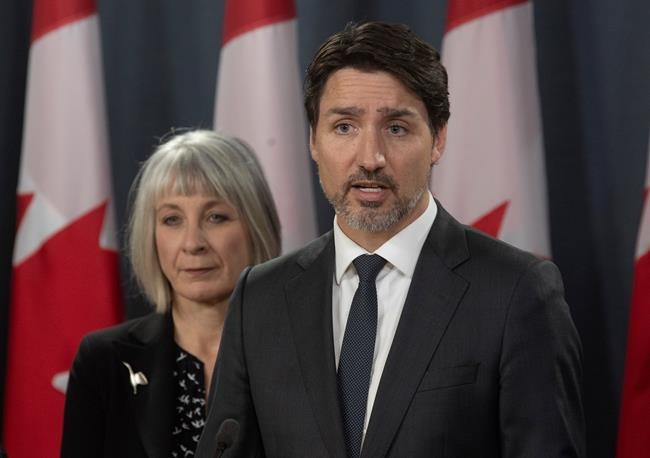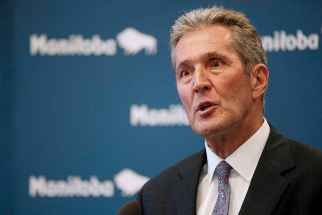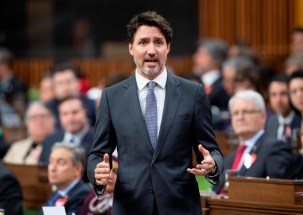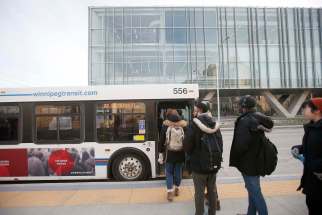Trudeau says government eyeing ways to curb COVID-19 spread as pandemic declared
Read this article for free:
or
Already have an account? Log in here »
To continue reading, please subscribe:
Monthly Digital Subscription
$0 for the first 4 weeks*
- Enjoy unlimited reading on winnipegfreepress.com
- Read the E-Edition, our digital replica newspaper
- Access News Break, our award-winning app
- Play interactive puzzles
*No charge for 4 weeks then price increases to the regular rate of $19.00 plus GST every four weeks. Offer available to new and qualified returning subscribers only. Cancel any time.
Monthly Digital Subscription
$4.75/week*
- Enjoy unlimited reading on winnipegfreepress.com
- Read the E-Edition, our digital replica newspaper
- Access News Break, our award-winning app
- Play interactive puzzles
*Billed as $19 plus GST every four weeks. Cancel any time.
To continue reading, please subscribe:
Add Free Press access to your Brandon Sun subscription for only an additional
$1 for the first 4 weeks*
*Your next subscription payment will increase by $1.00 and you will be charged $16.99 plus GST for four weeks. After four weeks, your payment will increase to $23.99 plus GST every four weeks.
Read unlimited articles for free today:
or
Already have an account? Log in here »
Hey there, time traveller!
This article was published 11/03/2020 (2107 days ago), so information in it may no longer be current.
OTTAWA – The federal government rolled out a $1-billion package Wednesday to help the country’s health-care system and economy cope with the novel coronavirus outbreak as the number of cases in Canada grew, Prime Minister Justin Trudeau warned that the situation could get worse, and the World Health Organization declared COVID-19 a global pandemic.
Multiple health authorities reported a flurry of new positive tests for COVID-19, including one person at Canadian Forces Base Trenton repatriated from a cruise ship docked in California, and a man in Sudbury, Ont., who had attended a large mining conference in Toronto.
That conference included appearances by Trudeau, Ontario Premier Doug Ford, and federal Natural Resources Minister Seamus O’Regan and Mary Ng, the minister of small business and international trade.
O’Regan and Ng are in self-isolation awaiting test results after showing symptoms of a respiratory illness, although O’Regan believes he has a simple head cold and Ng thinks she is suffering from asthma and a cold.
With more than 118,000 people sickened around the world, including more than 100 in Canada, the WHO called on countries to mitigate the social and economic impacts while minimizing the disruption to everyday life.
Trudeau said Canada’s government is considering more measures to contain COVID-19, such as what to do with incoming cruise ships, on which the disease has been known to spread, while warning cases could climb.
He demurred on when the government would opt for stricter measures like community-wide lockdowns, such as those in China and Italy.
“It’s not about time. It’s about the situation and the facts on the ground. We will closely monitor what is needed to be done to keep Canadians safe,” Trudeau said, flanked by key ministers and Canada’s chief public health officer.
“While we are prepared for a wide range of scenarios, we will focus right now on what needs to be done now and endeavour to make sure that is enough, that we don’t have to take future steps.”
In Washington on Wednesday night, President Donald Trump said the U.S. will suspend all travel from Europe, excluding the U.K., starting Friday for 30 days.
The outbreak has caused an upheaval in the Canadian economy, the cancellation of major conferences and events like the World Figure Skating Championships that were scheduled for next week in Montreal, changes in travel plans and workplace travel bans like those now imposed on parliamentary groups. Yukon Premier Sandy Silver said on Twitter he won’t attend a meeting with Trudeau and other premiers beginning Thursday “out of an abundance of caution.”
The Public Health Agency of Canada says the risk to the general population is low and most people diagnosed with COVID-19 experience manageable symptoms like a fever or cough. For some, such as seniors and those with compromised immune systems or pre-existing conditions, the illness can be more severe.
The first presumptive case east of Quebec was reported on Wednesday in New Brunswick.
Jennifer Russell, the province’s chief medical officer of health, says the case involves a woman between 50 and 60 years old in the southern part of the province. The woman recently travelled from France and is in self-isolation.

Among the Canadians diagnosed with the illness so far, fewer than 15 per cent have required hospitalization. One has died, a man who lived in a nursing home in Vancouver.
“I kind of have to quarantine myself from the public,” said 24-year-old Paul Redman, who has the genetic lung disorder cystic fibrosis and was on Parliament Hill on Wednesday to meet with MPs about drug regulations.
He added later that Canadians should “be aware that there are people who are very vulnerable out there, such as myself. If (I) get a cold, I could die.”
Individual behaviour — like washing hands and coughing into the crook of an elbow — can slow the spread of the infection.
Still, the government has been preparing its response “as if it was a pandemic,” said Health Minister Patty Hajdu, adding that the WHO’s labelling the outbreak a pandemic wasn’t a surprise, nor did it change the trajectory of federal plans. In the afternoon, she told a House of Commons committee the government expects between 30 and 70 per cent of Canadians could contract the disease.
Half of the $1-billion spending package will go to help provinces and territories prepare and react, and pay for protective gear like masks and gowns for health workers. Ontario’s government added $100 million for its response Wednesday, which could be used to hire more staff in the province.
A smaller portion of the spending eases access to federal benefits for workers whose livelihoods are disrupted by COVID-19, aiming to make it easier for people with more precarious jobs to stay home, avoid infecting others, and get income supports quickly.
Federal officials are eyeing ways to help those who don’t qualify for employment insurance receive benefits, possibly providing grants as was done during the SARS outbreak in 2003.
Federal lending is also going to ramp up to help businesses get credit to handle the economic shock, similar to a program during the financial crisis just over a decade ago that provided $11 billion to 10,000 firms.
The reaction from business and labour groups was that the funding is a start to deal with the uncertainty about the depth and duration of the economic shock to the country.
The Business Council of Canada said it made sense to “hold off on major economic stimulus measures” until more is known. The Canadian Chamber of Commerce called it a “a positive and pragmatic approach to the global risks of the spreading virus.”

Hassan Yussuff, president of the Canadian Labour Congress, said the package could help avoid job losses given he has heard stories of impending layoffs in the air-travel industry, and of seafood processors in Atlantic Canada watching demand for exports to China drop.
Politically, the package landed with more of a thud, with opposition criticism that the Liberals waited too long into the outbreak to act.
Conservative finance critic Pierre Poilievre said the Liberal response was short on specifics, including what exactly the spending will achieve, while the party’s health critic Matt Jeneroux said he wanted the Liberals to expand arrivals screening for passengers coming from countries where the virus is rampant, including Italy.
NDP Leader Jagmeet Singh said the Liberals should consider getting banks and credit-card companies to ease payments for those affected.
This report by The Canadian Press was first published March 11, 2020.
— With files from Stephanie Levitz and Laura Osman
— Follow @jpress on Twitter
Note to readers: This is a corrected story. A previous version misspelled the last name of Hassan Yussuff.
A breakdown of federal COVID-19 spending
OTTAWA – The federal government unveiled a $1 billion response package to mitigate the effects of COVID-19 on the Canadian health-care system, the economy, and workers. Here is the breakdown of the spending announced Wednesday.
OTTAWA – The federal government unveiled a $1 billion response package to mitigate the effects of COVID-19 on the Canadian health-care system, the economy, and workers. Here is the breakdown of the spending announced Wednesday:
$500 million: To help provinces and territories with things like buying equipment, increased testing for COVID-19, and enhanced surveillance and monitoring
$275 million: For research on medical countermeasures, including antivirals, vaccine development and support for clinical trials. This funding is on top of the $27 million previously announced.
$100 million: To pay for enhanced federal surveillance, increased testing at the National Microbiology Laboratory, and ongoing support for preparedness in First Nations and Inuit communities.
$50 million: To help buy personal protective equipment for health-care workers like surgical masks, face shields, and isolation gowns.
$50 million: To the Public Health Agency of Canada to pay for COVID-19 communications and public education.
$50 million: Initial support to the World Health Organization and other international groups to address the outbreak worldwide, particularly in developing countries.
$12 million: Expanding the work-sharing program from 38 to 76 weeks to supplement wages for workers who cut hours to avoid layoffs at companies affected by COVID-19.
$7 million: To repatriate Canadians from high-risk areas, such as those who were asymptomatic and arrived Tuesday morning from the Grand Princess cruise ship to begin quarantine at Canadian Forces Base Trenton.
$5 million: To waive the one-week waiting period for employment insurance sickness benefits for those who are in quarantine or have been directed to self-isolate.
-The Canadian Press
How EI benefits for COVID-19 quarantines will work
Prime Minister Justin Trudeau announced changes to Canada’s sick-leave benefits under employment insurance Wednesday, to respond to concerns about COVID-19.
Here is a quick overview of how the program works and what these changes mean.
Prime Minister Justin Trudeau announced changes to Canada’s sick-leave benefits under employment insurance Wednesday, to respond to concerns about COVID-19.
Here is a quick overview of how the program works and what these changes mean:
What are EI sick-leave benefits?
Eligible workers with no or limited paid-leave benefits through their employers can apply for up to 15 weeks of employment insurance if they cannot work for medical reasons such as cancer, a broken leg, or in this case, being quarantined in a public-health threat.
How is the government adjusting the program for COVID-19?
Normally, a worker who qualifies for the benefits has a one-week waiting period before payments start, so if you’re quarantined for two weeks you’d only get sickness benefits for one of those weeks.
For people quarantined due to COVID-19, the government is eliminating the waiting period entirely, so you can get EI benefits for an entire 14-day quarantine.
The government previously waived the waiting period, which was then two weeks, during the 2003 SARS epidemic.
Who qualifies for EI sick-leave benefits?
Employed Canadians who pay EI premiums, and self-employed people who register to participate in the EI program, will qualify if they cannot work because of a medical condition, have lost at least 40 per cent of their usual weekly pay, and worked a minimum of 600 hours in the year before the claim or since their last EI claim.
If you are self-employed and pay into EI, you have to wait at least 12 months after registering to make a claim.
Do I need a doctor’s note?
Normally a medical certificate signed by your doctor is required to get sick-leave benefits but a spokeswoman for Employment Minister Carla Qualtrough said the government is waiving the note for patients required to go into quarantine by law or by a public-health official.
People who are asked to self-isolate by their employers when public-health officials recommend it can also qualify.
The exact documentation required is still evolving, said Health Minister Patty Hajdu, but she said the goal is to minimize the effort required of a person who needs to go into quarantine.
What happens if I get sick and the quarantine period is extended?
If you are put into quarantine as a precaution and aren’t sick then, but later do test positive for COVID-19, a signed medical certificate confirming the diagnosis will be required for you to receive sick-leave EI benefits beyond the initial period of the quarantine.
How much will I receive from EI sick leave?
The current EI payment is 55 per cent of your earnings up to a maximum of $573 a week.
What if I don’t qualify for EI sick-leave benefits?
At the moment there is no program but the government is “exploring additional measures” to provide some kind of income support for Canadians not eligible for EI sickness benefits.
How much does the government think it will cost to do this?
The government is budgeting $5 million to waive the one-week waiting period. However Qualtrough acknowledged the cost could change depending on how widespread the outbreak is in Canada.
-The Canadian Press
How to protect yourself and others from COVID-19

Posted:
COVID-19 is now impacting the lives of Canadians on many levels and people across the country are seeking answers to numerous important questions they have about the novel coronavirus. Below is a summary:


















